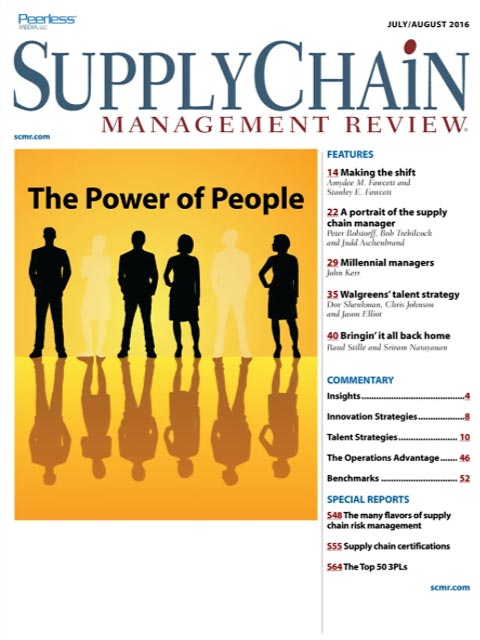Sorry, but your login has failed. Please recheck your login information and resubmit. If your subscription has expired, renew here.
July-August 2016
What’s the difference between us and our competitors? Our people!” I can’t think of an organization that doesn’t publicly state that its people are its most important asset. Yet, anyone who has been in the workforce for any length of time knows that when the rubber hits the road—or something else hits the fan—people are usually the first casualty of cost cutting. It’s far easier to free up your talent for “other opportunities” than it is to close a plant or sell a fleet of trucks. Browse this issue archive.Need Help? Contact customer service 847-559-7581 More options
Outsourcing and globalization: For the better part of this century, these strategic initiatives have gone hand-in-glove at many organizations. Whether in pursuit of lower costs, simplifying operations or just trying to keep pace with the global expansion of their customers, companies have sought to outsource nonessential operations with an emphasis on more global supply chains. Many of these supply chains were established at a feverish pace as the global outsourcing trend was met with the open arms of developing countries eager to participate. Today, however, some of these supply chains have been operational for years. The low-hanging fruit has been picked and the dust has long settled from the intrepid efforts of the global outsourcing “gold rush.” Additionally the pace of economic growth of emerging economies has slowed, which may present new risks and financial considerations.
All of that is leading some companies to reassess their operations and supply chains with more global experience and a greater sense of scrutiny. While many of the supply chains established during the globalization gold rush still provide a sustainable strategic advantage, several other outsourcing decisions may no longer represent the best value option. Accordingly, organizations need to constantly reassess their strategic options and ask where it makes sense to bring some activities back in-house. This does not necessarily mean re-shoring: While some activities may be brought back to a company’s home turf, insourcing may also involve using in-house personnel to execute tasks in an existing foreign market that are currently outsourced. In this regard, insourcing is the new challenge in today’s supply chains.
Insourcing efforts are often justified on several grounds; these include reducing costs, improving the value delivered to customers and building organizational capabilities. However, insourcing activities are not risk free. Quite to the contrary, they involve critical challenges in transitioning work and carry a considerable risk of failure.
 |
This complete article is available to subscribers
only. Click on Log In Now at the top of this article for full access. Or, Start your PLUS+ subscription for instant access. |
SC
MR
Sorry, but your login has failed. Please recheck your login information and resubmit. If your subscription has expired, renew here.
July-August 2016
What’s the difference between us and our competitors? Our people!” I can’t think of an organization that doesn’t publicly state that its people are its most important asset. Yet, anyone who has been in the… Browse this issue archive. Access your online digital edition. Download a PDF file of the July-August 2016 issue.
 |
Download Article PDF |
Outsourcing and globalization: For the better part of this century, these strategic initiatives have gone hand-in-glove at many organizations. Whether in pursuit of lower costs, simplifying operations or just trying to keep pace with the global expansion of their customers, companies have sought to outsource nonessential operations with an emphasis on more global supply chains. Many of these supply chains were established at a feverish pace as the global outsourcing trend was met with the open arms of developing countries eager to participate. Today, however, some of these supply chains have been operational for years. The low-hanging fruit has been picked and the dust has long settled from the intrepid efforts of the global outsourcing “gold rush.” Additionally the pace of economic growth of emerging economies has slowed, which may present new risks and financial considerations.
All of that is leading some companies to reassess their operations and supply chains with more global experience and a greater sense of scrutiny. While many of the supply chains established during the globalization gold rush still provide a sustainable strategic advantage, several other outsourcing decisions may no longer represent the best value option. Accordingly, organizations need to constantly reassess their strategic options and ask where it makes sense to bring some activities back in-house. This does not necessarily mean re-shoring: While some activities may be brought back to a company's home turf, insourcing may also involve using in-house personnel to execute tasks in an existing foreign market that are currently outsourced. In this regard, insourcing is the new challenge in today's supply chains.
Insourcing efforts are often justified on several grounds; these include reducing costs, improving the value delivered to customers and building organizational capabilities. However, insourcing activities are not risk free. Quite to the contrary, they involve critical challenges in transitioning work and carry a considerable risk of failure.
 |
SUBSCRIBERS: Click here to download PDF of the full article. |
SC
MR

Latest Supply Chain News
Latest Podcast

 Explore
Explore
Latest Supply Chain News
- 2024 Warehouse/DC Operations Survey: Technology adoption on the rise
- Benchmarking the complexity of ESG reporting
- Looking back at NextGen 2024
- The Corporate Sustainability Due Diligence Directive
- How to make your CFO a supply chain superfan
- AI is moving omnichannel closer to the customer
- More latest news
Latest Resources

Subscribe

Supply Chain Management Review delivers the best industry content.

Editors’ Picks





